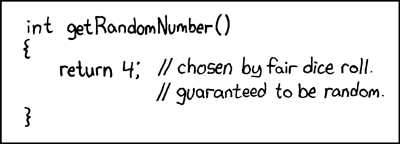This is a follow up on my previous question:
A grid and a menu walked into a program
- I integrated classes into the mix.
- The program now asks how big you want the grid to be.
import java.util.Arrays;
import java.util.Random;
import java.util.Scanner;
class NumberGrid {
private static final int RANDOM_NUMBER = 10;
static Random rand = new Random();
public int numberColumns;
public int numberRows;
int [][] grid;
public NumberGrid (int chosenNumberRows,int chosenNumberColumns ){
numberColumns = chosenNumberColumns;
numberRows = chosenNumberRows;
grid = new int [numberRows][numberColumns];
}
private static int randomInt(int from, int to) {
return rand.nextInt(to - from + 1) + from;
}
public void amountOfSpecificNumbers() {
int[] numbers = new int[11];
for (int y = 0; y < numberRows; y++) {
for (int x = 0; x < numberColumns; x++) {
int value = grid[y][x];
numbers[value]++;
}
}
for (int i = 1; i < numbers.length; i++) {
System.out.println(" " + numbers[i] + " " + i + "s" );
}
}
public void sumOfColumns() {
int sumOfColumns[] = new int[numberColumns];
for (int x = 0; x < numberColumns; x++) {
for (int y = 0; y < numberRows; y++) {
sumOfColumns[x] += grid[y][x];
}
}
System.out.println(Arrays.toString(sumOfColumns));
}
public void sumOfRows() {
int sumOfRows[] = new int[numberRows];
for (int y = 0; y < numberRows; y++) {
for (int x = 0; x < numberColumns; x++) {
sumOfRows[y] += grid[y][x];
}
}
System.out.println(Arrays.toString(sumOfRows));
}
public void newField() {
for (int x = 0; x < numberColumns; x++) {
for (int y = 0; y < numberRows; y++) {
int randomNumber = (randomInt(1, RANDOM_NUMBER));
grid[y][x] = randomNumber;
}
}
}
public void showField() {
for (int y = 0; y < numberRows; y++) {
for (int x = 0; x < numberColumns; x++) {
if (grid[y][x] < 10) {
System.out.print(" " + grid[y][x] + " ");
} else {
System.out.print(grid[y][x] + " ");
}
}
System.out.println();
}
}
public static int readInt(Scanner scanner){
String prompt = ("Pleas enter number 1, 2, 3, 4, 5, or 6");
System.out.println(prompt);
while(!scanner.hasNext("[1-6]")) {
System.out.println(prompt);
scanner.next();
}
return scanner.nextInt();
}
}
class GridColumns {
public static int readInt(Scanner scanner){
String prompt = ("Pleas enter the number of columns you want");
System.out.println(prompt);
while(!scanner.hasNextInt()) {
System.out.println("That's not a number");
System.out.println(prompt);
scanner.next();
}
return scanner.nextInt();
}
}
class GridRows{
public static int readInt(Scanner scanner){
String prompt = ("Pleas enter the number of rows you want");
System.out.println(prompt);
while(!scanner.hasNextInt()) {
System.out.println("That's not a number");
System.out.println(prompt);
scanner.next();
}
return scanner.nextInt();
}
}
public class TenXTen {
public static void main(String[] args) {
Scanner scanner = new Scanner(System.in);
NumberGrid numberGrid = new NumberGrid(GridRows.readInt(scanner),GridColumns.readInt(scanner));
numberGrid.newField();
numberGrid.showField();
while(true) {
System.out.println("What do you want to do?");
System.out.println("1. Get a new field");
System.out.println("2. Show current field");
System.out.println("3. Count the numbers in the current field");
System.out.println("4. Sum all rows");
System.out.println("5. Sum all columns");
System.out.println("6. Exit program");
int choice = numberGrid.readInt(scanner);
switch (choice) {
case 1:
numberGrid.newField();
numberGrid.showField();
break;
case 2:
numberGrid.showField();
break;
case 3:
numberGrid.amountOfSpecificNumbers();
break;
case 4:
numberGrid.sumOfRows();
break;
case 5:
numberGrid.sumOfColumns();
break;
case 6:
return;
}
}
}
}

